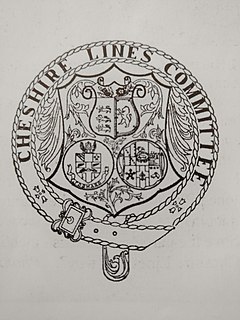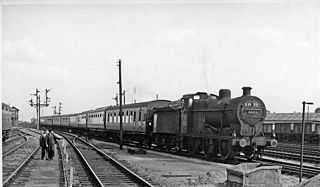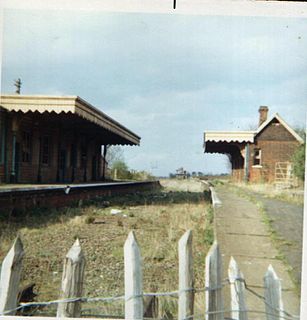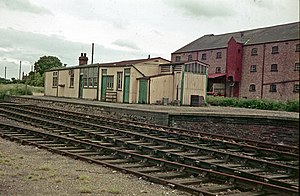
The Great Northern Railway (GNR) was a British railway company incorporated in 1846 with the object of building a line from London to York. It quickly saw that seizing control of territory was key to development, and it acquired, or took leases of, many local railways, whether actually built or not. In so doing, it overextended itself financially.

The Great Eastern Railway (GER) was a pre-grouping British railway company, whose main line linked London Liverpool Street to Norwich and which had other lines through East Anglia. The company was grouped into the London and North Eastern Railway in 1923.

The Cheshire Lines Committee (CLC) was formed in the 1860s and became the second-largest joint railway in Great Britain. The committee, which was often styled the Cheshire Lines Railway, operated 143 miles (230 km) of track in the then counties of Lancashire and Cheshire. The railway did not get grouped into one of the Big Four during the implementation of the 1923 grouping, surviving independently with its own management until the railways were nationalised at the beginning of 1948. The railway served Liverpool, Manchester, Stockport, Warrington, Widnes, Northwich, Winsford, Knutsford, Chester and Southport with connections to many other railways.

The Palace Gates Line was a short railway branch line in north London running from the main line at Seven Sisters station in Tottenham to Palace Gates station in Wood Green.

The Midland and Great Northern Joint Railway (M&GNJR) was a railway network in England, in the area connecting southern Lincolnshire, the Isle of Ely and north Norfolk. It developed from several local independent concerns and was incorporated in 1893. It was jointly owned by the Midland Railway and the Great Northern Railway, and those companies had long sponsored and operated the predecessor companies.

Peterborough railway station serves the city of Peterborough, Cambridgeshire, England. It is 76 miles 29 chains (122.9 km) down the East Coast Main Line from London King's Cross. The station is a major interchange serving both the north-south ECML, as well as long-distance and local east–west services. The station is managed by London North Eastern Railway. Ticket gates came into use at the station in 2012.

Gainsborough Lea Road railway station is one of two stations that serve the town of Gainsborough in Lincolnshire, England, the other station being Gainsborough Central, which is located in the town centre. The station is managed by East Midlands Railway and is located 14.25 miles (23 km) northwest of Lincoln Central on the A156 Lea Road in the south of the town. The station opened in 1867 on a single line of the Great Northern Railway, who ran four trains a day from Gainsborough to Lincoln.

Bungay railway station was located on the now disused Waveney Valley Line which ran between Tivetshall and Beccles. The station was closed in 1953 and the buildings eventually demolished to make way for the A143 road. It was one of two stations in Suffolk on the line, which curved across the county boundary then back into Norfolk.

Peterborough East was a railway station in Peterborough, England. It was opened on 2 June 1845 and closed to passenger traffic on 6 June 1966. Located on Station Road just off Town Bridge, only the engine sheds and one platform remain. The station had services running west to Northampton and Rugby, as well as to the east to March, Wisbech, and Norwich.
The Ely and St Ives Railway was a railway company that opened a line between those places in 1878. It was an extension of the privately promoted Ely, Haddenham & Sutton Railway that had opened in 1866. It was a standard gauge single track. The line was worked by the neighbouring Great Eastern Railway but it was never profitable. The development of road transport services in the 1920s caused a steep decline in use of the line, and the passenger service was withdrawn in 1931. A goods service continued, but the line closed completely in 1964. No railway activity takes place on the route now.
The Great Northern and Great Eastern Joint Railway, colloquially referred to as "the Joint Line" was a railway line connecting Doncaster and Lincoln with March and Huntingdon in the eastern counties of England. It was owned jointly by the Great Northern Railway and the Great Eastern Railway. It was formed by transferring certain route sections from the parent companies, and by the construction of a new route between Spalding and Lincoln, and a number of short spurs and connections. It was controlled by a Joint Committee, and the owning companies operated their own trains with their own rolling stock. The Joint Line amounted to nearly 123 miles of route.
Haughley railway station was located in Haughley, Suffolk on the Great Eastern Main Line between Liverpool Street Station and Norwich. It opened on 7 July 1849 named Haughley Junction and was a replacement for a station named Haughley Road which had been in service from 1846 to 1849 at location TM 02981 63319 on the line to Elmswell.

Somersham railway station was a station in Somersham, Cambridgeshire on the Great Eastern Railway between March and St Ives. There was also a branch line that ran north-west from the station to Ramsey. It opened in 1848, but was closed on 6 March 1967.
The Lancashire, Derbyshire and East Coast Railway (LD&ECR) was built to connect coalfields in Derbyshire and Nottinghamshire with Warrington and a new port on the Lincolnshire coast. It was a huge undertaking, and the company was unable to raise the money to build its line. With the financial help of the Great Eastern Railway it managed to open between Chesterfield and Lincoln with a branch towards Sheffield from 1896. Despite efforts to promote tourist travel, the passenger business was never buoyant, but collieries were connected to the line, at first and in succeeding years. The Great Eastern Railway, and other main line companies, transported coal to the southern counties, and the company's engines took coal to Immingham in great quantities. The company had a fleet of tank engines.
Holme railway station is a former station in Holme, Cambridgeshire.
Ramsey East railway station was a railway station in Ramsey, Cambridgeshire, which is now closed. It opened on 16 September 1889, and closed to passenger traffic on 22 September 1930, and to freight traffic on 17 September 1956. The site is now occupied by the west side of Bury Road Industrial Estate, and a new housing development aptly called Signal Road and The Sidings. It was the terminus of a branch line connected via Warboys railway station to Somersham, where it joined the main Great Eastern Railway line between St Ives and March, which at its upper end towards March is now occupied by the route A141 between Chatteris and March.

The East Lincolnshire Railway was a main line railway linking the towns of Boston, Louth and Grimsby in Lincolnshire, England. It opened in 1848. The ELR Company had leased the line to the Great Northern Railway, and it was the latter which constructed the line and operated it, as its East Lincolnshire Line.
The Downham and Stoke Ferry Railway was a branch line in western Norfolk, England.
The Kettering, Thrapston and Huntingdon Railway was an English railway line opened throughout in 1866. It connected the Midland Railway main line at Kettering to ironstone deposits to the south-east of the town, as well as opening up the agricultural district around Thrapston and reaching the regional centre of Huntingdon. The hoped-for expansion of agricultural was limited and local traffic did not develop; at the same time the difficult alignment and gradients of the line discouraged heavy use as a through line. A basic passenger service operated through from Kettering to Cambridge, by using running powers east of Huntingdon via St Ives.
The Lincolnshire lines of the Great Northern Railway are the railways, past and present, in the English county built or operated by the Great Northern Railway.












